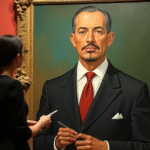Introduction
On July 14, 1824, the news of Agustín de Iturbide’s capture in Soto la Marina, Tamaulipas, caused a whirlwind of emotions among Mexicans. Iturbide, once a favored creole and military strategist for the Spanish royalist army, later became a key insurgent general championing Mexico’s liberation. He was the architect of the Plan de Iguala, which secured Mexico’s independence and led to the establishment of the First Mexican Empire. His capture sparked a wave of reactions, as people grappled with the sudden shift from celebrating his triumphant return to mourning his downfall.
Iturbide’s Rise and Fall
Two years prior, on July 21, 1822, Iturbide was crowned emperor in Mexico City amidst grand celebrations. The ceremony featured 24 cannon salutes, adorned churches and public buildings, and even three bishops officiating the mass. The people rejoiced as Iturbide was hailed as their luminous leader, bringing an end to Mexico’s struggle for independence. However, his reign was short-lived and fraught with challenges.
Opposition and Resistance
The Mexican Empire faced opposition from republican factions and the Spanish garrison at San Juan de Ulúa. Protests, demonstrations, and riots erupted as Iturbide’s rule became increasingly authoritarian. Fearing for their safety, affluent Spaniards left the empire, while supporters of the Plan de Iguala grew disillusioned and joined opposition groups. Felipe de la Garza, a brigadier from Nuevo Santander, proposed a republican government to the Congress, further fueling discontent.
Iturbide’s Arrest of Distinguished Deputies
In response to the growing opposition, Iturbide ordered the arrest of prominent deputies such as José Joaquín Herrera, Lombardo, Teresa de Mier, and Fagoaga. He justified his actions by citing the Constitution’s authority to apprehend conspirators. Despite his pleas for calm and patience, Iturbide’s rule plunged Mexico into chaos and poverty.
Iturbide’s Capture and Its Aftermath
In March 1823, less than a year after his coronation, Iturbide was urged to abdicate by the Congress due to the country’s dire situation. He left Mexico, but attempts to restore order failed in his absence. Various uprisings ensued, both for and against Iturbide, while he faced persecution in exile.
Iturbide’s Return and Final Days
In February 1824, Iturbide wrote to the Mexican Congress expressing his willingness to serve the government, which was under threat. However, he received no response and decided to return. Unaware of a Mexican government decree condemning him to death, Iturbide embarked on his journey from London on May 4, 1824. His fate was sealed.
Capture and Execution
Upon landing in Soto la Marina on July 14, Iturbide was captured, possibly due to his poor disguise and unique riding style. His swift trial and execution five days later, on July 19, in Padilla, Tamaulipas, marked the end of his tumultuous journey from hero to adversary.
Key Questions and Answers
- Who was Agustín de Iturbide? A Mexican military officer who played a crucial role in achieving Mexico’s independence from Spain and later became the country’s first emperor.
- Why was Iturbide’s capture significant? His capture sparked a range of emotions among Mexicans, as they grappled with the rapid shift from celebrating his triumphant return to mourning his downfall.
- What challenges did Iturbide’s reign face? His rule was marked by opposition from republican factions, discontent among supporters of the Plan de Iguala, and growing poverty and chaos in Mexico.
- What led to Iturbide’s abdication? Due to the worsening situation in Mexico, Iturbide was urged to abdicate by the Congress in March 1823.
- How did Iturbide’s return to Mexico end? Unaware of a decree condemning him to death, Iturbide’s return led to his swift capture, trial, and execution in July 1824.






